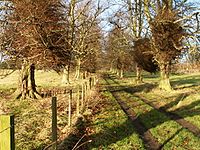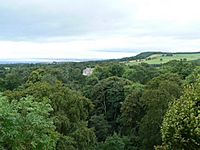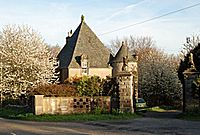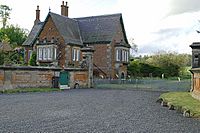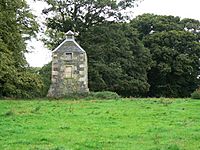Balcarres House facts for kids
Quick facts for kids Balcarres House |
|
|---|---|
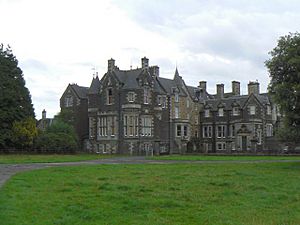
West façade of Balcarres House
|
|
| Built | 1595 |
| Built for | John Lindsay of Balcarres |
| Architect | William Burn, David Bryce (19th century additions) |
| Owner | Anthony, Earl of Crawford and Balcarres |
|
Listed Building – Category A
|
|
| Designated | 1 February 1972 |
| Reference no. | LB8625 |
|
Inventory of Gardens and Designed Landscapes in Scotland
|
|
| Official name: Balcarres | |
| Designated | 31 March 2005 |
| Reference no. | GDL00036 |
| Lua error in Module:Location_map at line 420: attempt to index field 'wikibase' (a nil value). | |
Balcarres House is a historic mansion located in eastern Scotland, near the village of Colinsburgh in Fife. It was first built in 1595 by John Lindsay. This grand house became the main home for the Earl of Crawford family.
Over the years, Balcarres House has been made much bigger, especially in the early 1800s. These changes used money earned in India. Even with all the new parts, the house still keeps many features of the original 1595 building. Balcarres House is considered a very important historic building in Scotland. Its beautiful gardens are also listed as significant landscapes.
Contents
Where is Balcarres House?
Balcarres House is in the southeast part of Fife, a region in Scotland. It is located between the villages of Largoward and Colinsburgh, about 3 miles (5 km) from the coast. The closest town is St Andrews, which is to the east.
From the house, you can see south towards the Firth of Forth. This is a large river mouth that opens into the sea. On a clear day, you might even see the skyline of Edinburgh, which is about 20 miles (32 km) away.
The Story of Balcarres House
The name Balcarres comes from the Scottish Gaelic words baile carrach. This means "rough" or "stony settlement."
Early Beginnings and First Buildings
The land where Balcarres House stands was first acquired in 1511 by Sir John Stirling. He was given the land by the Scottish King. He had to promise to build certain structures and farm the land. The first house he built was shaped like an "L." This original part is still found in the middle of the much larger house today.
In 1587, John Lindsay, Lord Menmuir bought the house from Sir John Stirling. He also bought other lands in Fife. These lands were made into a special area called a "barony" in 1592. John Lindsay built the main mansion in 1595, just three years before he passed away. This first building was a simple design. It was a type of strong house called a "Z-plan tower house." It even included an older tower that Sir John Stirling had built around 1511.
The Lindsay Family and Royal Connections
In 1633, King Charles I gave the title "Lord Lindsay of Balcarres" to David Lindsay. David was the second son of John Lindsay. David built a small chapel with a Gothic style. He was buried there when he died in 1641. This chapel still stands near the road today, but it no longer has a roof.
David's son, Alexander, was given the title "Earl of Balcarres" in 1651. He and his wife, Anna, supported the King's side during the English Civil War. Alexander died while living away from Scotland in 1659. During this time, Balcarres House was taken over by the Parliamentarians.
The Lindsay family continued to support the Stuart kings. In 1689, Colin, the 3rd Earl of Balcarres, was put in prison. He was later sent away from Scotland because he supported King James VII, who had been removed from power. Colin was allowed to return to Scotland in 1700. However, he took part in the Jacobite Rising of 1715, which was a rebellion that failed. After this, he was kept under house arrest at Balcarres. He later started the village of Colinsburgh near the house before he died in 1722.
Changes and Expansions
In 1789, the sixth Earl, Alexander, sold Balcarres to his brother, Robert Lindsay. Robert had become very wealthy in India. Robert's son, Colonel James Lindsay, inherited the house in 1836. He hired a famous architect named William Burn to make a big addition to Balcarres. He made sure to keep most of the old house inside the new design.
His son, Sir Coutts Lindsay, built another addition to the northeast side of the house. He also created the beautiful terraced gardens. These were designed by David Bryce in the 1860s. In 1886, Sir Coutts sold the estate to his nephew, James Ludovic Lindsay. He was the ninth Earl of Balcarres and the twenty-sixth Earl of Crawford. Balcarres House is still owned by the Earl's family today.
The Balcarres Estate
To the east of Balcarres House, there is a rocky hill called a crag. On this crag stands a "folly." A folly is a building built just for decoration. A famous preacher named John Blackadder once preached on this crag in the 1600s. This was during a time when people who followed the Covenanters were being treated badly. The folly was built around 1820. It looks like a Gothic tower surrounded by fake ruins.
The 17th-century chapel, which David Lindsay built, is protected as a special historic site. A sundial from the 1600s, brought from another castle, is also very important. There is also an old house called a "dower house" on the grounds. This house was built in the late 1600s or early 1700s.
The Balcarres estate is part of a group called East Neuk Estates. This group includes six local families who still live on and manage their historic estates. Many of these estates have been around since the Middle Ages and are still used for farming.
Gallery


